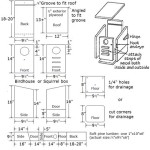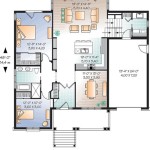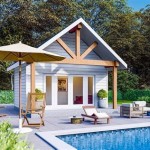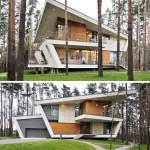A small house floor plan refers to a layout designed for a compact dwelling, typically with a limited surface area. Its primary purpose is to maximize space efficiency and functionality within a smaller footprint.
Small house floor plans are commonly employed in various settings, such as apartments, townhouses, or modest single-family homes. These plans prioritize efficient use of available space, optimizing the placement of rooms and minimizing wasted areas.
In the following sections, we will delve deeper into the key considerations, benefits, and design principles associated with small house floor plans. We will explore the advantages they offer in terms of space utilization, affordability, and sustainability, as well as provide practical tips and examples to guide you in designing your own efficient small house.
Here are 9 important points about small house floor plans:
- Maximize space efficiency
- Prioritize functionality
- Optimize room placement
- Minimize wasted areas
- Enhance affordability
- Promote sustainability
- Utilize vertical space
- Incorporate multipurpose areas
- Consider natural lighting
These key points underscore the advantages and design principles associated with small house floor plans, providing a foundation for creating compact and efficient living spaces.
Maximize space efficiency
Maximizing space efficiency is a cornerstone of small house floor plan design. Every square foot counts, so it’s essential to utilize space wisely and avoid any unnecessary clutter or wasted areas.
- Open floor plans: By eliminating walls between certain areas, such as the living room, dining room, and kitchen, you can create a more spacious and fluid layout. This approach promotes better flow and makes the space feel larger.
- Multifunctional furniture: Opt for furniture that serves multiple purposes. For instance, a coffee table with built-in storage can double as a storage unit, while a sofa bed can provide both seating and sleeping arrangements.
- Vertical storage: Utilize vertical space by incorporating shelves, drawers, and cabinets that extend upwards. This helps keep items organized and frees up valuable floor space.
- Built-in appliances and fixtures: Consider built-in appliances, such as ovens and refrigerators, as they can save space compared to freestanding models. Additionally, built-in storage units, desks, and benches can maximize space utilization without compromising on functionality.
By implementing these space-saving strategies, you can create a small house floor plan that feels both comfortable and efficient, making the most of every square foot.
Prioritize functionality
In a small house, every square foot needs to serve a purpose. Prioritizing functionality means designing a floor plan that supports your daily routine and activities, ensuring that each space is utilized efficiently and effectively.
1. Define your needs: Start by identifying your essential needs and activities. Consider how you use your home, what functions are most important to you, and what kind of lifestyle you want to support. This will help you determine which rooms and spaces are non-negotiable and which ones can be adapted or eliminated.
2. Optimize traffic flow: Pay attention to how people move through the house. Create a floor plan that allows for smooth and efficient movement between different areas, avoiding bottlenecks or awkward transitions. Wide hallways, well-placed doorways, and open sightlines can enhance the functionality and livability of your small space.
3. Use space-saving solutions: Incorporate space-saving features and furnishings throughout your home. Built-in storage, multi-purpose furniture, and vertical storage solutions can help you maximize space utilization without sacrificing functionality. For example, a kitchen island can serve as both a food preparation area and a dining table, while a Murphy bed can provide a comfortable sleeping space that disappears into the wall when not in use.
4. Create flexible spaces: Consider designing flexible spaces that can adapt to different needs and activities. For instance, a spare room can double as a guest room, home office, or playroom. Multi-purpose areas allow you to maximize the functionality of your small house while maintaining a sense of openness and spaciousness.
By prioritizing functionality in your small house floor plan, you can create a home that meets your specific needs and supports your lifestyle, ensuring that every square foot is used wisely and efficiently.
Optimize room placement
Optimizing room placement in a small house floor plan is crucial for maximizing space efficiency and creating a functional and comfortable living environment. Here’s how to approach room placement strategically:
1. Prioritize natural light: Position rooms that require ample natural light, such as the living room, dining room, and bedrooms, towards the side of the house with the most windows. Natural light not only brightens up the space but also makes it feel more spacious and inviting.
2. Group similar functions together: Place rooms with similar functions adjacent to each other to create efficient work zones. For instance, group the kitchen, dining room, and pantry together to facilitate meal preparation and serving. Similarly, locate the bedrooms and bathrooms in close proximity to minimize wasted steps.
3. Consider adjacencies and transitions: Carefully consider how different rooms connect and transition into one another. Avoid placing rooms that require privacy, such as bedrooms and bathrooms, directly next to high-traffic areas like the living room or kitchen.
4. Utilize vertical space: Don’t limit yourself to the horizontal plane when optimizing room placement. Utilize vertical space by incorporating lofts, mezzanines, or built-in storage units to create additional living or storage areas without sacrificing floor space.
By carefully considering these factors and optimizing room placement, you can create a small house floor plan that maximizes natural light, promotes efficient movement, and makes the most of every square foot.
Minimize wasted areas
In a small house, every square foot counts. Minimizing wasted areas is crucial for creating a space-efficient and functional floor plan. Here are four key strategies to help you achieve this goal:
- Eliminate unnecessary hallways and corridors: Wasted circulation space can eat up valuable square footage. Consider open floor plans or alternative ways to connect rooms, such as archways or pocket doors.
- Utilize corners and awkward spaces: Don’t let corners and odd-shaped areas go unused. Built-in storage units, shelves, or seating can be customized to fit these spaces, maximizing storage and functionality.
- Consider multi-purpose furniture and spaces: Choose furniture that serves multiple functions, such as ottomans with built-in storage or sofa beds that double as guest sleeping arrangements. Multi-purpose spaces, like a dining area that can also be used as a home office, can save valuable square footage.
- Maximize vertical space: Utilize vertical space by incorporating loft beds, built-in shelves, and storage units that extend upwards. This approach helps keep items organized and frees up valuable floor space.
By implementing these strategies, you can minimize wasted areas in your small house floor plan, ensuring that every square foot is utilized efficiently and contributes to the overall functionality and comfort of your home.
Enhance affordability
Small house floor plans offer significant advantages in terms of affordability, making them an attractive option for budget-conscious homeowners and first-time buyers. Here’s how a small house floor plan can help you save money:
- Reduced construction costs: The smaller the house, the less it will cost to build. A smaller footprint means less materials, labor, and time required for construction, resulting in lower overall costs.
- Lower property taxes: Property taxes are often based on the square footage of your home. By opting for a smaller house, you can reduce your taxable square footage and potentially lower your annual property tax bill.
- Energy efficiency: Smaller homes are naturally more energy-efficient than larger ones. With a smaller space to heat and cool, you can save money on energy bills throughout the year.
- Lower maintenance costs: A smaller house requires less maintenance and upkeep compared to a larger one. This can translate to savings on repairs, renovations, and general maintenance over the long run.
In addition to these direct cost savings, small house floor plans can also contribute to your financial well-being in indirect ways:
- Reduced mortgage payments: With a smaller mortgage loan amount, you can secure a lower monthly mortgage payment, freeing up more of your income for other expenses or investments.
- Increased affordability in desirable locations: In competitive real estate markets, smaller homes can make homeownership possible in desirable neighborhoods that might otherwise be out of reach with a larger house.
By choosing a small house floor plan, you can not only save money on construction and maintenance costs but also improve your overall financial situation, making homeownership more accessible and affordable.
Promote sustainability
Small house floor plans not only offer financial benefits but also contribute to sustainability and environmental conservation. Here’s how a small house floor plan can promote sustainability:
- Reduced material consumption: Smaller homes require less building materials, leading to a reduction in resource consumption and environmental impact. This includes materials such as lumber, concrete, and insulation.
- Lower energy usage: Smaller homes have a smaller carbon footprint due to reduced energy consumption. With less space to heat and cool, small houses require less energy, resulting in lower greenhouse gas emissions.
- Increased energy efficiency: Small house floor plans can be designed to maximize energy efficiency by incorporating passive design principles and energy-saving features. This can include optimizing natural light, utilizing energy-efficient appliances, and implementing renewable energy systems.
- Reduced waste production: Smaller homes generate less waste during construction and throughout their lifespan. With less space to fill and furnish, there is less waste associated with materials, packaging, and consumer goods.
By choosing a small house floor plan, you can contribute to environmental sustainability and reduce your impact on the planet while enjoying the benefits of a comfortable and efficient living space.
Utilize vertical space
Maximizing vertical space is crucial in small house floor plans to create the illusion of more space and improve functionality. By utilizing the vertical dimension, you can add storage, create additional living areas, and make your home feel more spacious and airy.
- Loft beds and sleeping areas: Utilize the vertical space in bedrooms by incorporating loft beds or sleeping areas. This frees up valuable floor space below, which can be used for other purposes such as storage, seating, or a home office.
- Built-in shelves and storage units: Install built-in shelves and storage units that extend upwards to maximize vertical space. These can be used to store books, dcor, and other items, keeping them organized and out of the way.
- Vertical gardens and living walls: Create a living wall or vertical garden to add greenery and purify the air while utilizing vertical space. This can be a beautiful and functional addition to any room.
- Mezzanines and lofts: If your small house has high ceilings, consider adding a mezzanine or loft to create an additional living area or sleeping space. This can provide extra square footage without expanding the footprint of your home.
By incorporating these vertical space utilization techniques, you can create a small house floor plan that feels both spacious and efficient, making the most of every cubic foot of space.
Incorporate multipurpose areas
In small house floor plans, incorporating multipurpose areas is a clever way to maximize space and functionality. By designing spaces that can serve multiple purposes, you can create a home that is both efficient and versatile.
1. Convertible guest room/home office: Convert a spare bedroom into a multipurpose space that can accommodate guests and double as a home office. Choose furnishings that can easily transition between functions, such as a sofa bed or a desk that can be used as a dining table.
2. Kitchen/dining/living area: Combine the kitchen, dining room, and living room into an open-plan concept. This creates a spacious and inviting central hub where you can cook, eat, relax, and entertain guests.
3. Playroom/storage area: Designate a playroom that can also serve as a storage area for toys, games, and other belongings. Built-in storage units and multi-purpose furniture can help keep the space organized and clutter-free.
4. Laundry/mudroom: Combine the laundry room with the mudroom to create a functional and efficient space. Install cabinets and shelves to store cleaning supplies, shoes, and coats, keeping them out of sight.
By incorporating multipurpose areas into your small house floor plan, you can create a home that is both space-efficient and adaptable to your changing needs.
Consider natural lighting
Natural lighting plays a crucial role in creating a comfortable and inviting atmosphere in any home, but it is especially important in small house floor plans. Maximizing natural light can make a small space feel larger, brighter, and more connected to the outdoors.
1. Position windows strategically: Place windows on walls that receive ample sunlight throughout the day. South-facing windows are ideal, as they allow for maximum natural light exposure. Consider installing large windows or sliding glass doors to bring in even more light.
2. Use reflective surfaces: Incorporate reflective surfaces into your design to bounce natural light around the room. Light-colored walls, mirrors, and glossy finishes can help distribute light more evenly, making the space feel brighter and more spacious.
3. Avoid blocking natural light: Be mindful of furniture placement and window treatments. Avoid placing large pieces of furniture or heavy curtains directly in front of windows, as this can block natural light from entering the room.
4. Consider skylights and solar tubes: If your floor plan does not allow for ample natural light through windows, consider installing skylights or solar tubes. These features can bring natural light into interior spaces that would otherwise be dark and gloomy.
By incorporating these natural lighting strategies into your small house floor plan, you can create a home that is filled with natural light, making it feel more spacious, comfortable, and inviting.










Related Posts








